Western Music History – 5 –
The history of Western music is explained.
This blog explains Romantic.
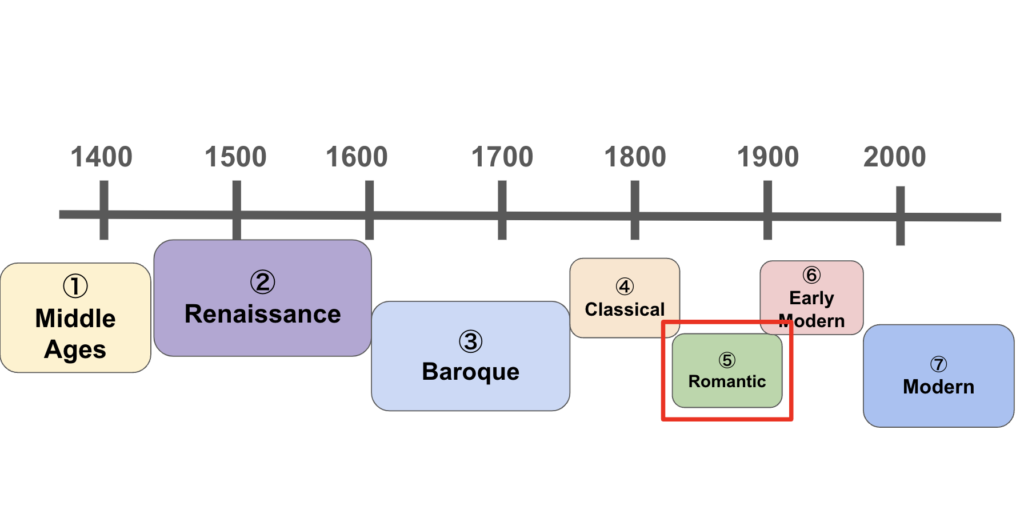
- Middle Ages
- Renaissance
- Baroque
- Classical
- Romance
- Early Modern
- Modern
5. Romantic Era Part I

The Romanticism movement was born out of a rebellion against the modern rationality enlightenment
Romanticism grew out of a backlash against the excessive pursuit of rationality.
The French Revolution, Napoleonic Wars, and Industrial Revolution drastically changed the existing order and values. The emancipation of the oppressed spread quickly throughout Europe, but the immaturity of the perception of freedom at the time led to social turmoil.

People have desires regardless of status or position. The general public, which had been forced into forced rationality during the era of absolute monarchy, had a stronger desire for wealth than for freedom.
In a manner different from the extravagant Baroque period and the balanced Classical period, Romantic artists pursued freedom and individuality.

Called the DNA of an artist, artists of the Romantic era enjoyed the arts and created works that emphasized sensitivity and creativity. This led to sophistication, originality, and diversification of countries and lands.
During the Romantic era, the characteristics and tastes of each country became clear and distinct, especially in the four countries of Germany, Italy, England, and France.
A view of the start of the Romantic Era in the music of Beethoven in his later years
Both Bach and Mozart were revolutionary figures in the history of Western music, and Beethoven is one such person.
The fact that many historians claim that Beethoven’s death in 1827 marked the beginning of the Romantic Era suggests that he was a great revolutionary.

Beethoven’s culminating work, the String Quartet Grosse Fugue, composed in his later years, is so dissonant that it is difficult to discern the main key signature. This is atonal music that appeared 100 years later. It also shows his skill in using small musical motifs of three or four notes to create a large piece of music.
However, music critics and musicians of the time failed to appreciate the excellence of his compositions, and this piece, composed as the last movement of a string quartet, was dropped from the program. Only the Grosse Fugue remained as a stand-alone work.
When he worked on this piece, he was nearly deaf. It may be that Beethoven was able to make use of atonal music that appeared 100 years later because he immersed himself in music theory and continued to compose throughout his life, even though he was unable to converse with others.
Early Romantic Music: The Development of Salon Music and the Birth of Lieder
The Central Cemetery in Vienna, Austria, which flourished as the capital of music during the Classical and Romantic eras, is a sacred place that Western music lovers should not miss. In the Central Cemetery in Vienna, the graves of Beethoven, Schubert, Brahms, and Strauss II stand side by side around a monument to Mozart.

Beethoven’s funeral was a state-wide affair, with many in attendance, among them Schubert, who had admired Beethoven. Early Romantic music included Schubert, Brahms Weber, Schumann, Chopin, and Mendelssohn, all of whom were strongly influenced by Beethoven’s music. Their different fields of music show the diversification of Romanticism.
The expressive piano was valued in the Schubert, Schumann, and Chopin salons, which were based on a new field of activity called salon music, and in addition to piano solos, the chamber music culture of piano quintets, which combined piano and strings, and Liederlieder, which combined voice and piano, flourished.
Chopin’s piano music, which is still frequently performed today, developed into technical performances through the unique expressive methods of Romanticism.
Many piano exercises were also composed during this period, and Schumas left behind a collection of small piano works for children, which are still used today. This act of refining one’s playing technique may seem Enlightenment-like and rational, but it incorporated the beauty of expression that Romanticism emphasized, and even today it is sometimes performed as concert music. Piano-centered salon music attracted a great deal of interest from musicians and music lovers, and female musicians also emerged, creating diversity.

A particular development in salon music is the German lieder. Lieder has a simple instrumental structure of sung voice and piano, which allows for individual differences in musical expression through words and voice and interpretation of poetry. Although operatic arias and songs accompanied by keyboard instruments existed, it was the fusion with literary romanticism that developed during the Romantic era that made the lied attractive.
German songs were composed by Mozart and Beethoven even during the Classical era, but it was Schubert, who worked on more than 600 songs, who greatly developed them. Schumann, Brahms, and Mendelssohn also wrote songs during the same era, but even considering Schubert’s short life of 31 years, his contribution is outstanding.
The addition of Romantic German literature to such songs establishes a genre not found in opera arias. A diversity of expression was born.
From this time on, attention began to focus on the background in which the music was written, the thoughts of the composer, and the player’s interpretation of the music and method of expression. Schumann composed songs characterized by beautiful melodies and piano accompaniments intensively in 1840, making the most of his piano playing technique. That year was the year before his upcoming marriage to Clara Wieck (later Clara Schumann), and it is largely due to Clara’s influence that his songs became so appealing.

Movement for the science of music, establishment of music theory
Brahms was found by Schumann. Brahms is best known for his instrumental works such as symphonies and concertos, but he also left many song works such as lullabies. He developed his own unique musical world with a scientific and theoretical approach, making full use of bass and mid-bass notes and triplets.

His music is very distinctive, but it is influenced by Beethoven because he admired Beethoven
Rational attempts to make music a science, especially with Brahms, developed during the early Romantic era.
Music theory was dominated by methods of learning from past musical works, and the Romantic era was able to learn from the music of previous eras. The most important of these historical rediscoveries were the musical works of Bach. The works of Bach, a church musician, were found by Mendelssohn in the early Romantic era, and the way Bach’s music developed harmony and tonality was revolutionary in advancing our understanding of music theory. Like Beethoven, Bach anticipated the music of his time by more than 100 years.

Early Romantic music. There was a series of industrial revolutions, and “ideals,” “sensibility,” and “dreams” were born out of a rebellion against rationalism.
Romanticism, which is the exact opposite of rationalism, reached its destination in the pursuit of secular themes such as “love,” “hatred,” “joy,” and “sorrow.” Developing from there, longing for nature, love of one’s hometown and nation, and longing for the Orient led to late Romantic music.
During the Late Romantic period, music boxes also reached their heyday, changing from cylinder music boxes to disc music boxes.
The culmination of Romantic music, the High Romantic Era
Early Romantic music focused on “freedom,” “individuality,” and “imagination,” and the period from the 1830s to the 1850s was the time when it reached its maturity. The most important point is the German Romantic operas and Wagner’s Musical Drama.
Unlike the piano salon music of the early Romantic era, Wagnarian is a comprehensive art form that brings together all the arts experienced in the opera house: script, music, art, acting, and dance.
While opera music consisted of overtures, arias, major choruses, choruses, and interludes, the musical opera style removes the divisions and is an unbroken musical work from beginning to end. There is a pursuit of realism and a more realistic depiction of the characters’ psychology. This technique was originally developed by Schubert in the early Romantic era, who used the same technique in his songs.
Wagner’s music uses atonal music without tonality due to its nature of being a single work of music from beginning to end. This free and flexible Wagnerian style was introduced by the musicians of the late Romantic era.
[Branching out from Late Romantic music
The iconic musicians of the Late Romantic era, Mahler, Bruckner, and Richard Strauss, incorporated Wagner’s flexible style not only into their operas but also into large-scale instrumental music such as symphonies and symphonic poems.
For musicians, the emotional expression of Romanticism is an exemption.
Pursuing creative music that could express their individuality, they introduced new instruments and expanded orchestras to create flexible and free music
Romantic music was separated into two parts: the traditional classical and the modernized. Late Romantic music was classical. It valued the music of Wagner and Brahms, and Richard Strauss valued the music of Mozart in the Classical era.
Schoenberg, who established 12-tone music, and others pursued too much individuality and evolved into music that was difficult for the masses to understand.
The Romantic era was led by German music, but in France and Italy, the characteristics of the Romantic music of the High Romantic period evolved in their own unique ways.
Among these, in Italy, the birthplace of opera, verismo opera, or love-hate drama with a mythological theme, was expressed.
Verdi and Puccini were among the musicians who created verismo opera, but it evolved in its own unique way, influenced by the nationalism and admiration for the Orient that characterized this era.
[Music boxes in their heyday with enriched late Romantic music].
Music boxes also became popular during the Late Romantic period, when Romantic music matured and entered a new era.
Because music boxes were handmade and could not be mass-produced, they were considered luxury items and were owned by the wealthy. Cylinder music boxes were the mainstream at the time, but due to technological innovation and the influence of Romantic music, the disc music box was developed in Germany in the 1860s.
This disc type music box was inexpensive, mass-produced, and spread rapidly due to the convenience of being able to enjoy different music by changing discs.
The music box market also expanded from Europe to the Americas, and music box factories were established in the United States.
This market expansion led to the production of disc-type music boxes in Switzerland, but they soon lost market share to the gramophone, which was soon to appear. Thus, after the heyday of the music box in the 1880s, the music box declined from the music market.
Today’s digitally competitive society resembles the Enlightenment of this Romantic era.

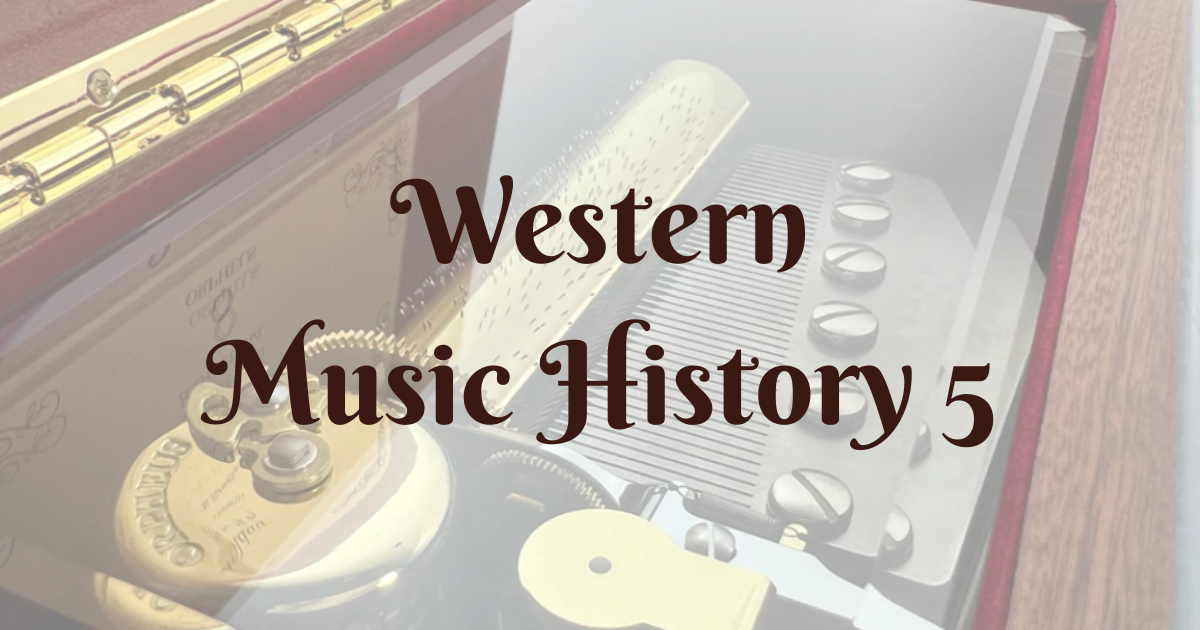
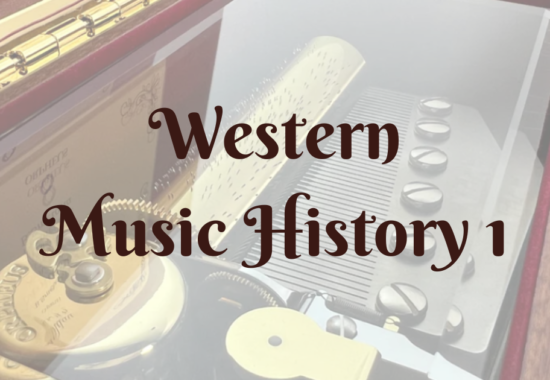
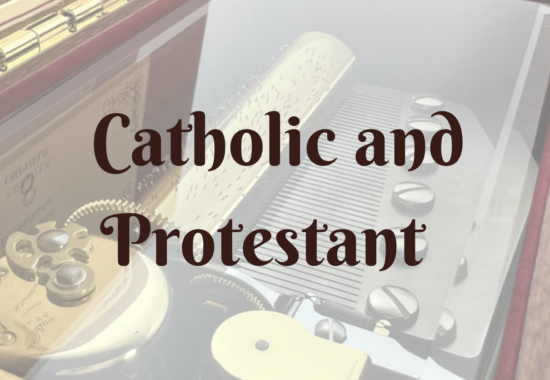
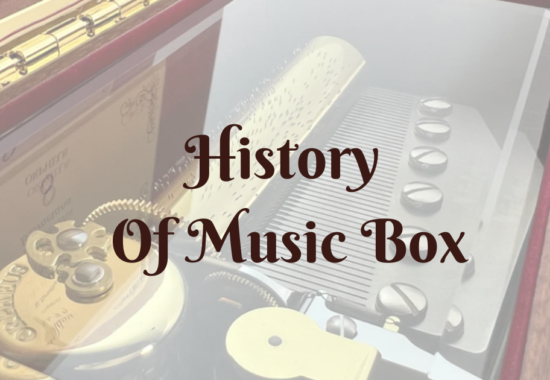
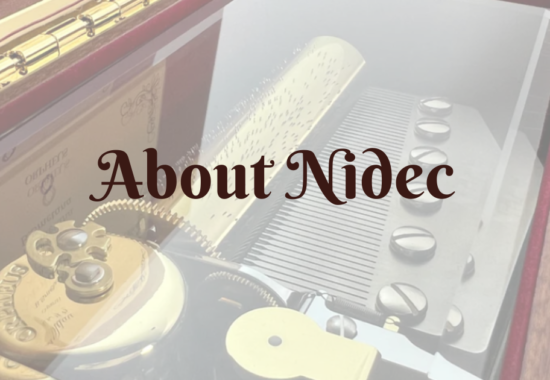
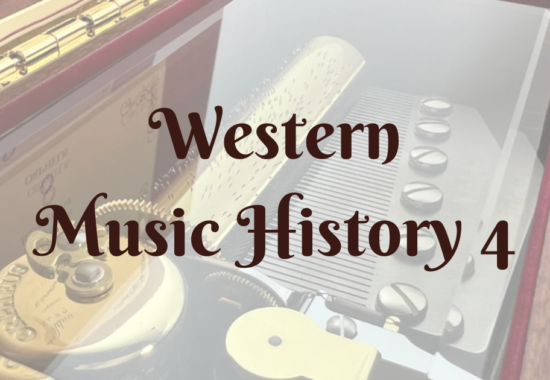
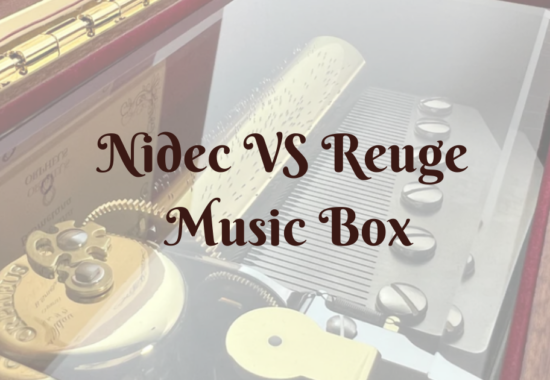
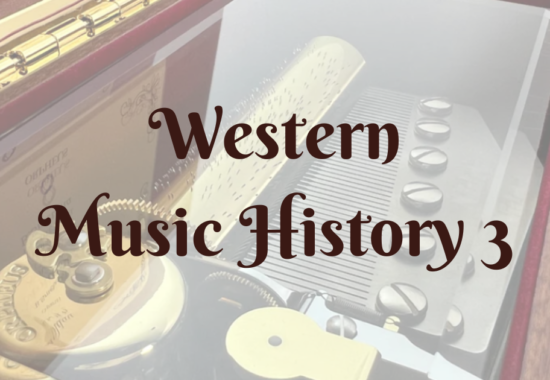

この記事へのコメントはありません。